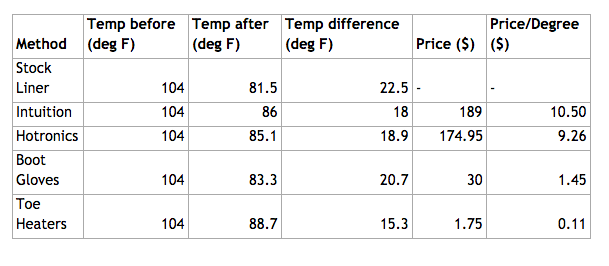
by Lindsay Mann and Liza Sarychev
A common problem faced by skiers of every ability level is cold feet. There are several solutions to this problem available for purchase. In this mini-study, we compare the heat kept and price point of the most widely used options.
We are looking to gather information to best determine the dollar cost per degree of heat kept in order to help inform potential buying decisions.
Mini Study Design
We compared the following boot heating methods:
- Stock Liner
- Intuition Power Wrap Liner
- Boot Glove
- Hotronic
- Toe Warmers
To compare them we used the following process:
- Fill a 3.7 oz container with water that is at 104 deg F
- Insert the container into the toe box of the boot, adding a ball to the midfoot area and another ball to the calf area to ensure the container stays put and less heat is escaping through the cuff.
- Place in a cooler, cover with ice. Wait 30 minutes.
- Insert thermometer into container to determine the temperature of the water.
- Repeat with Hottronics (in stock liner)*
- Repeat with Toe Warmers (in stock liner)
- Repeat with Boot Gloves (stock liner)
*Because the Hotronics require a specific footbed, this footbed will be used in all tests.
Total Time to Complete Test ~ 2.5 Hours
Results

Take Aways
Since it’s hard to objectively determine the lifetime of each method, it’s hard to conclude the most cost-effective method overall but it would seem that:
- If you don’t ski often, toe heaters are the most cost-effective option. Cons: take a considerable amount of room, don’t work with tight-fitting boots. Only last 6 hours, if that at cold temps.
- Boot gloves are the cheapest per degree option if you use them 14 days or more. Especially cost-effective in the long run since they have the longest lifespan of all options. Cons: some say they’re unfashionable, not a suitable option for extreme cold.
- Intuition liners and Hotronics are comparable options in terms of price and function, with Hotronics being slightly cheaper, but Intuitions being slightly warmer. Cons: Extra weight of Hotronics batteries.
Potential Issues
- Handling time (getting the water ready, in the boot, and in the cooler) varied slightly, could have skewed results, although it is doubtful.
- If the tennis ball sat differently, some heat could have been lost through the cuff. We did try to make sure the tennis ball sat the same way every time.
- We used two coolers with the same amount of ice, but the temperature inside the coolers could have dropped for each consecutive test. We tested over a 2.5 hr period
- Stock liners (100+ Days) and intuition (30 + days) liners have both been used in the field and were not new for this test. Age of each of these liners could have affected the results.
Next Steps
What is the lifetime of each of these heating methods?
If we can determine the lifespan of each option we can further determine which is the most cost-effective heating element for consumers.
Video of Liza Performing the Mini Study:
Questions, Comments, Feedback? Email coach@mtntactical.com
You Might Also Like MTI’s 30 Minute Per Day Dryland Ski Training Plan
